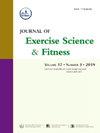Effects of crank length on cycling efficiency, sprint performance, and perceived fatigue in high-level amateur road cyclists
IF 2.4
2区 医学
Q2 SPORT SCIENCES
引用次数: 0
Abstract
Purpose
This study aimed to evaluate the effects of three different crank lengths (165 mm, 170 mm, and 175 mm) on cycling efficiency, sprint performance, and perceived fatigue in high-level amateur road cyclists.
Methods
A single-blind, randomized crossover design was employed, involving 28 trained male cyclists who completed three trials, each using a different crank length. Performance metrics, cycling economy (CE) including 20-min cycling under 60 % VO2MAX, peak and average power during a 6s sprint, cadence, heart rate, and perceived exertion, were measured using validated ergometers and metabolic analyzers.
Results
The results indicated significant differences in 60 %VO2MAXRPE were observed between the 165 mm and 175 mm cranks (p < 0.001, δ = −0.72) and between the 175 mm and 170 mm cranks (p < 0.001, δ = −0.67). In contrast, no significant difference was observed between the 165 mm and 170 mm cranks (p = 0.25, δ = −0.17). For 60 %VO2MAX, 6sMaxPower, 6sAVPower, 6sAVRpm, CE, 60 %VO2MAXAVHeart, 6sMaxRpm no significant differences were observed between any of the crank length groups (p > 0.34).
Conclusion
For high-level amateur road cyclists, using a 165 mm or 170 mm crank reduces subjective fatigue compared to a 175 mm crank, influencing affecting cycling efficiency or sprint performance. These findings help refine crank length recommendations to optimize performance, reduce injury risk, and improve comfort for high-level amateur road cyclists.
曲柄长度对高水平业余公路自行车手骑行效率、冲刺表现和感知疲劳的影响
目的研究高水平业余公路自行车手三种不同曲柄长度(165 mm、170 mm和175 mm)对骑行效率、冲刺表现和感知疲劳的影响。方法采用单盲、随机交叉设计,28名训练有素的男性自行车手完成3个试验,每个试验使用不同的曲柄长度。性能指标,循环经济性(CE),包括在60% VO2MAX下的20分钟循环,6秒冲刺期间的峰值和平均功率,节奏,心率和感知运动,使用验证的测力仪和代谢分析仪进行测量。结果165 mm曲柄与175 mm曲柄的60% VO2MAXRPE差异显著(p <;0.001, δ = - 0.72)和175 mm和170 mm曲柄之间(p <;0.001, δ = - 0.67)。相比之下,165 mm和170 mm曲柄之间没有显著差异(p = 0.25, δ = - 0.17)。对于60% VO2MAX, 6sMaxPower, 6sAVPower, 6sAVRpm, CE, 60% VO2MAXAVHeart, 6sMaxRpm,曲柄长度组之间没有显著差异(p >;0.34)。结论高水平业余公路自行车运动员使用165 mm或170 mm曲柄比使用175 mm曲柄更能减轻主观疲劳,影响骑行效率或短跑成绩。这些发现有助于完善曲柄长度建议,以优化性能,减少受伤风险,并提高高水平业余公路自行车手的舒适度。
本文章由计算机程序翻译,如有差异,请以英文原文为准。
求助全文
约1分钟内获得全文
求助全文
来源期刊
CiteScore
5.10
自引率
3.60%
发文量
54
审稿时长
31 days
期刊介绍:
The Journal of Exercise Science and Fitness is the official peer-reviewed journal of The Society of Chinese Scholars on Exercise Physiology and Fitness (SCSEPF), the Physical Fitness Association of Hong Kong, China (HKPFA), and the Hong Kong Association of Sports Medicine and Sports Science (HKASMSS). It is published twice a year, in June and December, by Elsevier.
The Journal accepts original investigations, comprehensive reviews, case studies and short communications on current topics in exercise science, physical fitness and physical education.

 求助内容:
求助内容: 应助结果提醒方式:
应助结果提醒方式:


